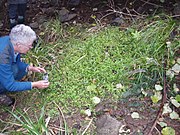Mentha cunninghamii
| New Zealand mint, Māori mint | |
|---|---|

| |
| Scientific classification | |
| Kingdom: | Plantae |
| Clade: | Tracheophytes |
| Clade: | Angiosperms |
| Clade: | Eudicots |
| Clade: | Asterids |
| Order: | Lamiales |
| Family: | Lamiaceae |
| Genus: | Mentha |
| Species: | M. cunninghamii
|
| Binomial name | |
| Mentha cunninghamii | |
| Synonyms | |
| |
Mentha cunninghamii, known commonly as New Zealand mint or Māori mint,[3] is a species within the Mentha (mint) genus, endemic to New Zealand.[4][5]
Name
[edit]The plant was named to honor English botanist Allan Cunningham, who was known for his plant collections in Australia and New Zealand.[6] In addition to its English-language names, several Māori language common names for the plant are also attested, including: hīoi,[7] moki and mokimoki.[8][9] The latter is a term also used for the unrelated ferns Microsorum scandens and Doodia caudata.[10]
Description
[edit]Mentha cunninghamii shares a mint odor with other species within the Mentha genus, but in appearance is very distinct from many other mints.[6] It has been suggested that it may actually be more closely related to members of the Micromeria genus.[11]
It is a slender, wiry, prostrate perennial plant, with a creeping rhizome. The plant is much branched, often matted, with numerous stems arising from the rhizome, diffusely branched, pubescent, growing from two to twelve inches long.[12] Its leaves are shortly petiolate or nearly sessile, 1/6 to 1/2 inches long, broadly ovate or almost orbicular, obtuse, entire or with an obscure notch on each side, and glandular-dotted. Its flowers are small, white, axillary, usually solitary but sometimes with two to three in each axil. Its peduncles are slender and variable in length. Its calyx are about 1/8 inches long, tubular-campanulate in shape, densely hairy, with teeth villous within. Its corolla-lobes are almost equal, flat and spreading, with the upper one shortly bifid. Its stamens protrude equally with the corolla or are slightly exserted.[12]
Distribution
[edit]
Mentha cunninghamii is endemic to the four islands of North Island, South Island, Chatham Island and Stewart Island in New Zealand.[6] It is found sparsely in grassy fields and open land generally.[13][14] It inhabits an elevation range from coastal to alpine, within a range of sea level to 4,500 feet (1,400 metres).[12] Sources variously describe its flowering season as beginning in the Southern Hemisphere in either September[4] or November,[15] ending in April.[6]
As of 2018, New Zealand's Department of Conservation's New Zealand Threat Classification System (NZTCS) assesses Mentha cunninghamii's conservation status as "At Risk: Declining."[1] The system uses the Declining status to indicate populations that currently possess large populations, but are experiencing declines that could eventually lead to a listing as "Threatened."[16]
Use
[edit]Mentha cunninghamii has been used by New Zealand's Māori people as a diaphoretic (meant to induce sweating). The leaves are also used for their scent, including in cooking.[3] It is described as easily cultivatable in many gardens.[17]
Notes
[edit]- ^ a b "Species Details". NZTCS. Retrieved 2021-01-29.
- ^ "Mentha cunninghamii Benth". GBIF Secretariat. 2019. Retrieved 2021-01-29.
- ^ a b "Mentha cunninghamii. Hioi. New Zealand mint". Māori Plant Use Database. Retrieved 2021-01-29.
- ^ a b "Taxon Profile - Mentha cunninghamii". Flora of New Zealand. Retrieved 2021-01-29.
- ^ "Mentha cunninghamii (Benth.) Benth". The Plant List. Retrieved 2021-01-29.
- ^ a b c d Lange, P.J. "Mentha cunninghamii". New Zealand Plant Conservation Network. Retrieved 2021-01-29.
- ^ Cheeseman 1906, p. 1095.
- ^ Cheeseman 1906, p. 1101.
- ^ "New Zealand mint, Mentha cunninghamii Benth". Museum of New Zealand Te Papa Tongarewa. Retrieved 2021-01-29.
- ^ "mokimoki - Māori Dictionary". Māori Dictionary. Retrieved 2021-01-30.
- ^ Tucker & Naczi 2006, p. 3.
- ^ a b c Cheeseman 1906, p. 568.
- ^ Allan 1961, p. 962.
- ^ "New Zealand mint Mentha cunninghamii". Rare Species. Retrieved 2021-01-29.
- ^ Webb, Sykes & Garnock-Jones 1988, p. 782.
- ^ Townsend, Andrew J.; de Lange, Peter J.; Duffy, Clinton A.J.; Miskelly, Colin M.; Molloy, Janice; Norton, David A. (January 2008). New Zealand Threat Classification System manual (PDF). Wellington, New Zealand: Science & Technical Publishing Department of Conservation. ISBN 9780478143645. Retrieved 2 February 2018.
- ^ "Mentha cunninghamii". Wai-ora. Retrieved 2021-01-29.
References
[edit]- Cheeseman, Thomas Frederick (1906). Manual of the New Zealand Flora. Wellington: Government Printer.
 This article incorporates text from this source, which is in the public domain.
This article incorporates text from this source, which is in the public domain. - Allan, H.H. (1961). Indigenous Tracheophyta - Psilopsida, Lycopsida, Filicopsida, Gymnospermae, Dicotyledons. Flora of New Zealand. Vol. 1. Wellington: Government Printer.
- Tucker, Arthur O.; Naczi, Robert F. C. (2006-12-13). "Mentha: An Overview of Its Classification and Relationships". In Brian M. Lawrence (ed.). Mint: The Genus Mentha. Medicinal and Aromatic Plants - Industrial Profiles (1st ed.). Boca Roton: CRC Press. pp. 1–40. ISBN 978-0-8493-0798-0.
- Webb, C.J.; Sykes, W.R.; Garnock-Jones, P.J. (1988). Naturalised Pteridophytes, Gymnosperms, Dicotyledons. Flora of New Zealand. Vol. 4. Wellington: Government Printer.
External links
[edit] Data related to Mentha cunninghamii at Wikispecies
Data related to Mentha cunninghamii at Wikispecies
![]() This article incorporates text from Manual of the New Zealand Flora, a publication from 1906, now in the public domain in the United States.
This article incorporates text from Manual of the New Zealand Flora, a publication from 1906, now in the public domain in the United States.

